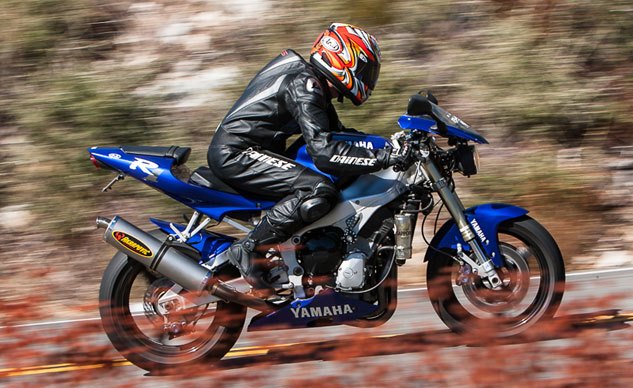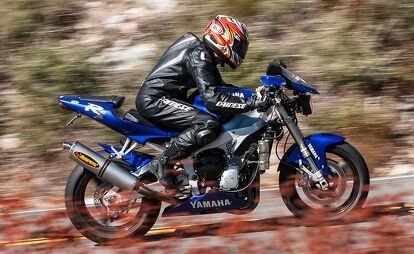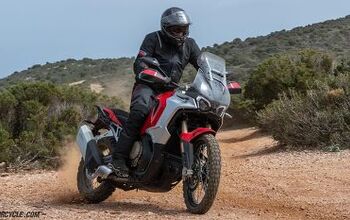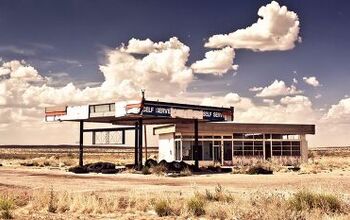2000 Yamaha R1 Project Bike: A Garage Space Odyssey Part II
Our $1500 Craigslist crumpet turns into a beautiful butterfly
We last left you hanging November 1 with Part I of our Evan Steel Performance-built 2000 Yamaha R1 project bike, wherein ESP took our hard-knock $1,500 Craigslist R1 and turned the old girl into, if not quite a beauty, a liter-bike packing enough performance to run with a much younger crowd. A little cylinder head work and a little bump-up in compression, a little crankshaft lightening, a little expert Dynojet carb-kitting and Akrapovic race-pipeage – nothing really radical, in other words – and here’s what we’ve come up with.
Never begin a sentence with a number; 148 horsepower is none too shabby. Our stated goal was to outperform the current R1, which we achieved. The last time MO ran an R1 on the dyno was in 2011, when that year’s model cranked out 145 hp at 11,750 rpm. Note how our old “long-stroke” motor gets there at just past 10,000 rpm. Torque is what Open-class bikes are all about, and our old beast has lots of it. Where before it made almost 72 pound-feet at 9000 rpm, it’s now above 70 lb-ft from 5000 rpm – and humps up around 80 lb-ft beginning around 7500 rpm. Compare and contrast, K-Mart shoppers, to the 79.7 lb-ft produced by the BMW S1000R in our 2014 Super Naked Street Brawl, which has to spin up to 9500 rpm to make that much.
You might expect that extracting 13-percent more power from an already high-performance engine might make it peakier, but that’s not the case with this one: The after curve is just an elevated version of the before, and ESP’s carburetion expertise leaves it almost completely devoid of spikes or dips. Newer bikes make more power through more rpm; what I love about my old beast is the lower-revving way it goes about making its power. In freeway-cruise mode, it reminds me of the inline-6 in my old Jaguar as much as a high-performance motorcycle engine, so calm and soothing, even. The difference being that the old R1 can rocket up to over 150 mph in what feels like about two seconds.
As for the three pounds APE removed from the crankshaft, I don’t miss it at all; maybe I’d need to ride back-to-back with a stocker to remember the difference? What is noticeable, at various rpm when cruising, is a complete absence of typical four-cylinder buzz. It’s a sweetheart, and really not at all loud at small throttle openings.
Lightness
Weighed with an empty gas tank, like we weighed them all at my former workplace, the old beast came in at a very svelte 392 pounds. On the same scale, a BMW S1000R weighs 432 dry, and the KTM Super Duke R 445 pounds. Yamaha’s claim for a 2014 R1 is 454 pounds wet, which translates to 426 pounds with its tank empty and is probably optimistic on their part. By any measuring stick, though, our old R1 is really, really light – light enough to achieve a superior power-to-weight ratio to all of the bikes mentioned. Apparently all those electrons on the newer bikes are quite heavy.
It’s not like I spent a bundle on exotic parts. Our Akrapovic stainless race system removes a few pounds, so do the Buell XB headlights we used instead of the stockers. Losing the fairing lowers is good for a few pounds. A Shorai lithium-iron battery removes about six pounds compared to the old lead-acid variety, and has been dead-reliable for the past few years, since before the bike was shipped off to ESP in Phoenix, in fact, which no doubt saved a lot of jumping.
Wait, There’s More …
For what I had in mind – a naked high-performance streetbike – we could’ve stopped about right there at the $7,500 mark, and I’d’ve been very happy with a freshen-up of the stock suspension. But Evan Steel didn’t want to let his roadracing expertise go to waste or his contacts untapped, so we also got $2,825 worth of high-end suspension components, a JRi shock out back and GP Components inserts for our forks. At subsonic street speeds, these don’t do much to improve the ride, and the shock, mounted via a Graves Motorsports linkage, raises the seat at least an inch even with the length-adjustable shock at its shortest. I don’t mind tiptoeing around, but I’m not a fan of having a little more weight shifted onto my wrists. Maybe it’s time for an LSL Superbike bar kit?
On the other paw, maybe I did tell Evan my bike might see the occasional track day, and in fact, ESP did deliver the nearly finished project back into our possession at a Chuckwalla trackday last year, attended by our old friend, three-time world champ Freddie Spencer. What we had failed to address by that time was fitment of the steering damper, and really any attention at all to the braking department – one area where it became immediately clear that the new bikes have really made a major advance in the ensuing 14 years. The bike accelerates hard enough to get itself into a headshake from time to time now, which knocked the brake pads back in the calipers a few times, requiring a couple of preliminary pumps from the champ. But Freddie, veteran of many long test days with Honda back in the day, seemed completely non-plussed. “That’s what you get with light weight,” he shrugged, “Everywhere you don’t need to slow down, the thing works great.”
What I’ll always remember from that day is thinking ‘I’ve got you at last, Fast Fred,’ as I prepared to drive past the champ on a new ZX-10R coming off Chuckwalla’s big bowl turn, TC lights flickering, only to have FF and my old R1 drive across my bow leaving a dark tracer right before my wide eyeballs and pull a big gap down the straight. Dang. How’d he do that?
Partly because my R1 was wearing sticky Dunlop GPAs to the Kawasaki’s stock Bridgestones, but mostly because of a gaping talent gap. In any case, FF gave the R1 two thumbs up and his autographical approval on the tail section.
If the suspension’s a bit firm on the street, once rolling over 100 mph or so, the old beast really does feel super snubbed down and as in-control as any modern bike. It did by our second Chuckwalla day, anyway, because by then I’d got the steering damper mounted and the brakes looked after. After that first track day under Fast Freddie’s abuse, the discs really looked terrible and we didn’t know if they could be saved. What worked was media-blasting them in the high-tech cabinet at MotoGPWerks.
A fresh set of OEM pads ($16 on eBay) and some Galfer stainless lines (about $50 more, on eBay), and the R1’s brakes are good as new. Which is to say not quite as good as modern ones with ABS, but not bad either. I only regret that Freddie wasn’t around on day two: Like the best race bikes I’ve occasionally gotten to ride over the years, my old R1 just doesn’t feel like it’s trying very hard or going very fast. Then you find yourself gaining on people who usually pass you, hitting apexes you usually miss, etc.
On the street, she’s a little hard-edged compared to a brand-new R1 with its lusty-purr crossplane crank and cush stock suspension, but maybe that’s part of the “vintage bike” experience, which I guess is where we are now at 14 years old. Time flies … I remember riding the first R1 in Cartagena like it was yesterday, sniff… Then again, it’s nice to be on a basic motorcycle that doesn’t even have a clock, much less a clock and 15 other items blinking at you suspiciously from the LCD/TFT display. The orange light is the only one you need to pay attention to. You’re low on gas, fool. If there’s no lights, somebody stole your battery.
What Would You Expect to Pay?
What we wound up with is a 148-hp R1 that’s also way torquey, perfectly carbureted, remarkably light and therefore easy to ride – relaxing, even, compared to the current crop. It runs fine on 91 octane, but race gas is good for track days just to be on the safe side, and for the smell and the bump-up in power it brings. Grand total for our R1 comes in at $10,179, compared to $14,290 for a 2014 R1 (our target), and $16,490 for the all-new ’15 model, complete with MotoGP-derived electronics package. Is the new R1 way nicer and more modern? Of course. Is it any faster around the track or up racer road? Depends on who’s riding it, really.
Did Evan Steel’s unofficial stopwatch have Fast Freddie going faster on the old R1 than his times on a brand-new ZX-10R that day? Yes. And that was just the shakedown cruise before we mounted the steering damper and fresh brakes and braided steel lines. Evan, suitably impressed as he watched Fast Fred rule Chuckwalla on his R1 baby, summed it all up in his usual deadpan style: “Watch out for old guys on old bikes.”
Basically, we’re still in the piston era. When Yamaha builds a jet-powered R1, my 2000 will be ready for the museum. Until then, it’s a completely viable alternative. Humongous old-bike thanks to Evan and Phil at ESP, and everybody who pitched in to give new life to my dear old beast. This thing is not over.
More by John Burns













































Comments
Join the conversation
Please don't try to justify the cost of these mods by comparing it to a new bike purchase! First, you don't pay MSRP for 2014 R1 (anyone who does, is a tool), with very little negotiation you should be able to get it on the road around $12K. A better negotiator might saved more ( I am suck at negotiation). Second, a new bike come with financing and resale value, I want to see you try to sell that bike for $10K. Of course you don't have to sell it, but the for the most of people sometime you need to sell you stuff to cover emergency expenditure.
PS: I used to own a 2000 R1 (bought it brand new, and sold it after 12 years), all that bike needs were, SS brake lines and Vesrah brake pads, stiffer front fork springs and rear shock linkage. I should have kept it and trust me there is no day I don't regret my decision to sell it.
I guess it would be criminal to compare this jewel to that de-cloaked ZX9 you had a few years back...but what was your total investment in that bike?